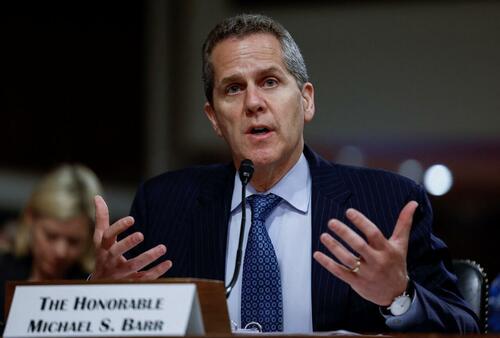
Authored by Alex Pollock via The Mises Institute,
Published in The New York Sun:
Central bankers whistle ‘Dixie’ as mark-to-market losses dramatically shrink the banking system’s economic capital.
Whistling a happy tune, the Federal Reserve vice chairman for supervision, Michael Barr, recently testified to Congress that “overall, the banking system remains sound and resilient.”
A more candid view of the risks would be less sanguine.
Mr. Barr reported that banking “capital ratios increased throughout 2023.” He failed, though, to discuss the mark-to-market losses that have dramatically shrunk the banking system’s economic capital and capital ratios.
A recent study of American banks, including analyses of both their securities and fixed rate loans, estimates that the banking system has at least a $1 trillion mark-to-market loss resulting from the move to normalized interest rates.
Since that loss is equal to half of the banks’ approximately $2 trillion in book value of tangible equity, their aggregate real capital has dropped by about 50 percent. This is just in time for them to be confronted with large potential losses from that classic source of banking busts, commercial real estate, as the prices of many buildings are falling vertiginously.
Given his current position, Mr. Barr could not be expected to mention another particularly large and inescapable threat to financial stability, that from the Federal Reserve itself. As central bank not only to the United States, but to the dollar-using world, the Fed combines great power with an inevitable lack of knowledge, and its actions are a fundamental source of financial instability.
When the Federal Reserve was created, the secretary of the treasury at the time, William Gibbs McAdoo, proclaimed that the Fed would “give such stability to the banking business that extreme fluctuations in interest rates and available credits… will be destroyed permanently.” A remarkably bad prediction.
Instead, throughout the life of the Fed, the financial system has suffered recurring financial crises and Fed mistakes. Mistakes by the Fed are inevitable because the Fed is always faced with an unknowable economic and financial future. This explains its poor record at economic forecasting, including inflation and interest rates.
No matter how intelligent its leaders, how many Ph.D.s it hires, how many computers it buys, how complex it make its models, or how many conferences it holds at posh resorts, the Fed cannot reliably predict the future results of its own actions, let alone the unimaginably complex global interactions that create the economy.
The Fed held both short-term and long-term interest rates abnormally low for more than a decade. It manipulated long term rates lower by the purchase of $8 trillion of mostly fixed rate Treasury bonds and mortgage securities, mostly funded by floating rate deposits, making its own balance sheet exceptionally risky. It decided to manage the expectations of the market, and frequently assured one and all that interest rates would be “lower for longer” (until, of course, they were higher for longer).
Observe the result: Gigantic interest rate risk built up in the banking system. A notable case was Silicon Valley Bank, which made itself into a 21st century version of a 1980s savings and loan, investing heavily in 30-year fixed rate mortgage-backed securities and funding them with short-short term deposits, while its chief executive served on the Board of the Federal Reserve Bank of San Francisco.
SVB was doing basically the same thing with its balance sheet that the Fed was. In the SVB case, it became the one of the largest bank failures in American history; in the Fed’s case, it has suffered its own mark to market loss of more than $1 trillion, in addition to operating cash losses of $172 billion so far. Adding the mark-to-market losses of the Fed and the banking system together, we have a total loss of $2 trillion. We are talking about real money.
The Fed was the Pied Piper of interest rate risk and consequent losses.
Jim Bunning was the only man ever to be both a Hall of Fame baseball player and a U.S. Senator. He pitched a perfect game in the major leagues, and he delivered a perfect strike in the Senate when Chairman Ben Bernanke was testifying on how the Fed was going to regulate systemic financial risk. In paraphrase, Senator Bunning asked, “How can you regulate systemic risk when you are the systemic risk?” There is no answer to this superb question.
Authored by Alex Pollock via The Mises Institute,
Published in The New York Sun:
Central bankers whistle ‘Dixie’ as mark-to-market losses dramatically shrink the banking system’s economic capital.
Whistling a happy tune, the Federal Reserve vice chairman for supervision, Michael Barr, recently testified to Congress that “overall, the banking system remains sound and resilient.”
A more candid view of the risks would be less sanguine.
Mr. Barr reported that banking “capital ratios increased throughout 2023.” He failed, though, to discuss the mark-to-market losses that have dramatically shrunk the banking system’s economic capital and capital ratios.
A recent study of American banks, including analyses of both their securities and fixed rate loans, estimates that the banking system has at least a $1 trillion mark-to-market loss resulting from the move to normalized interest rates.
Since that loss is equal to half of the banks’ approximately $2 trillion in book value of tangible equity, their aggregate real capital has dropped by about 50 percent. This is just in time for them to be confronted with large potential losses from that classic source of banking busts, commercial real estate, as the prices of many buildings are falling vertiginously.
Given his current position, Mr. Barr could not be expected to mention another particularly large and inescapable threat to financial stability, that from the Federal Reserve itself. As central bank not only to the United States, but to the dollar-using world, the Fed combines great power with an inevitable lack of knowledge, and its actions are a fundamental source of financial instability.
When the Federal Reserve was created, the secretary of the treasury at the time, William Gibbs McAdoo, proclaimed that the Fed would “give such stability to the banking business that extreme fluctuations in interest rates and available credits… will be destroyed permanently.” A remarkably bad prediction.
Instead, throughout the life of the Fed, the financial system has suffered recurring financial crises and Fed mistakes. Mistakes by the Fed are inevitable because the Fed is always faced with an unknowable economic and financial future. This explains its poor record at economic forecasting, including inflation and interest rates.
No matter how intelligent its leaders, how many Ph.D.s it hires, how many computers it buys, how complex it make its models, or how many conferences it holds at posh resorts, the Fed cannot reliably predict the future results of its own actions, let alone the unimaginably complex global interactions that create the economy.
The Fed held both short-term and long-term interest rates abnormally low for more than a decade. It manipulated long term rates lower by the purchase of $8 trillion of mostly fixed rate Treasury bonds and mortgage securities, mostly funded by floating rate deposits, making its own balance sheet exceptionally risky. It decided to manage the expectations of the market, and frequently assured one and all that interest rates would be “lower for longer” (until, of course, they were higher for longer).
Observe the result: Gigantic interest rate risk built up in the banking system. A notable case was Silicon Valley Bank, which made itself into a 21st century version of a 1980s savings and loan, investing heavily in 30-year fixed rate mortgage-backed securities and funding them with short-short term deposits, while its chief executive served on the Board of the Federal Reserve Bank of San Francisco.
SVB was doing basically the same thing with its balance sheet that the Fed was. In the SVB case, it became the one of the largest bank failures in American history; in the Fed’s case, it has suffered its own mark to market loss of more than $1 trillion, in addition to operating cash losses of $172 billion so far. Adding the mark-to-market losses of the Fed and the banking system together, we have a total loss of $2 trillion. We are talking about real money.
The Fed was the Pied Piper of interest rate risk and consequent losses.
Jim Bunning was the only man ever to be both a Hall of Fame baseball player and a U.S. Senator. He pitched a perfect game in the major leagues, and he delivered a perfect strike in the Senate when Chairman Ben Bernanke was testifying on how the Fed was going to regulate systemic financial risk. In paraphrase, Senator Bunning asked, “How can you regulate systemic risk when you are the systemic risk?” There is no answer to this superb question.
Loading…





